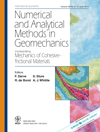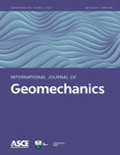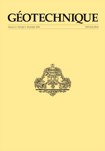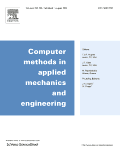
INTERNATIONAL JOURNAL FOR NUMERICAL AND ANALYTICAL METHODS IN GEOMECHANICS
Scope & Guideline
Fostering Knowledge in Analytical Geomechanics
Introduction
Aims and Scopes
- Numerical Modeling Techniques:
The journal emphasizes the development and application of various numerical modeling techniques, including finite element methods (FEM), discrete element methods (DEM), and computational fluid dynamics (CFD), to solve complex geomechanical problems. - Analytical Solutions:
A core aim is to provide analytical solutions for a variety of geomechanical issues, facilitating a deeper understanding of the underlying mechanics while offering simpler, often more computationally efficient alternatives to numerical methods. - Geotechnical Engineering Applications:
The journal covers practical applications in geotechnical engineering, including foundation analysis, slope stability, tunneling, and soil-structure interaction, focusing on both theoretical advancements and real-world implications. - Multi-Physics and Coupled Processes:
Research that explores coupled processes (e.g., hydro-mechanical, thermo-mechanical, or chemical-mechanical interactions) is a significant focus, reflecting the complexity of real-world geomechanical systems. - Innovative Material Behavior Models:
The journal encourages studies that introduce new constitutive models for representing the behavior of various soil types, including unsaturated soils, granular materials, and complex geological formations.
Trending and Emerging
- Artificial Intelligence and Machine Learning:
There is a growing trend towards utilizing AI and machine learning techniques for predictive modeling and optimization in geomechanics, reflecting the broader technological advancements in data analysis and computational modeling. - Advanced Materials and Constitutive Models:
Research focusing on advanced materials, such as biocemented soils and complex material behavior under varying conditions, is trending, showcasing innovations in constitutive modeling that aim to enhance the understanding of material responses. - Coupled Hydro-Mechanical and Thermo-Mechanical Analyses:
Emerging themes increasingly involve coupled analyses that consider multiple physical processes, such as hydro-mechanical and thermo-mechanical interactions, highlighting the complexity of subsurface conditions and material behaviors. - Sustainable Geotechnical Practices:
There is a noticeable increase in research related to sustainable practices in geotechnical engineering, including studies on the environmental impact of geotechnical projects and the use of eco-friendly materials and methods. - Numerical Techniques for Complex Geomechanical Problems:
The journal exhibits a rise in publications utilizing cutting-edge numerical techniques to tackle complex geomechanical issues, such as large deformation analysis and multi-scale modeling, indicating a shift towards more sophisticated computational approaches.
Declining or Waning
- Traditional Soil Mechanics:
There appears to be a waning interest in conventional soil mechanics topics that do not incorporate advanced modeling techniques or innovative materials, as the field moves towards more complex and computationally intensive studies. - Static Analysis Methods:
Static analysis methods, including those that do not account for dynamic loading conditions, seem to be declining. Researchers are increasingly focusing on dynamic and time-dependent analyses reflecting real-world scenarios. - Empirical Studies Without Numerical Support:
Papers that rely solely on empirical data without a strong numerical or analytical framework are becoming less common. The trend is shifting towards studies that integrate empirical findings with robust modeling techniques.
Similar Journals

International Journal of Numerical Analysis and Modeling
Advancing the Frontiers of Numerical AnalysisThe International Journal of Numerical Analysis and Modeling, published by ISCI-INST SCIENTIFIC COMPUTING & INFORMATION, is a leading platform for research in the field of numerical analysis. With an ISSN of 1705-5105 and an E-ISSN of 1705-5105, this esteemed journal has been disseminating rigorous and innovative studies since its inception in 2004. Covering a diverse range of topics within numerical analysis, it has successfully positioned itself in Q2 of the 2023 category quartiles and ranks 46th out of 88 in its Scopus classification, showcasing its relevance and impact within the academic community. Operating under an open access model, it ensures that research findings are accessible to a global audience, fostering collaboration and knowledge exchange. Based in Canada, this journal not only highlights advancements in computational methodologies but also addresses real-world applications, bridging theoretical frameworks with practical solutions. Researchers, professionals, and students alike will find valuable insights and up-to-date contributions in this crucial field of study.

International Journal of Geomechanics
Elevating geotechnical engineering through impactful scholarship.The International Journal of Geomechanics, proudly published by the American Society of Civil Engineers (ASCE), stands as a pivotal cornerstone in the fields of geotechnical engineering, engineering geology, and soil science. With an esteemed Q1 ranking in both geotechnical engineering and soil science as of 2023, it represents a high-impact platform (impact factor information to be inferred as impressive given the rankings and prominence in the field). Since its inception in 2001, this journal has been committed to advancing the understanding of geomechanical processes, offering a vital forum for researchers, professionals, and students to disseminate innovative findings and practical applications. The journal is indexed by Scopus, holding an impressive position at rank #48 out of 229 in its disciplines, illustrating its significance and influence in the academic community. Although it does not currently offer open access, the journal continues to attract a diverse readership with its critical insights into soil behavior, earth structures, and various geotechnical challenges. The International Journal of Geomechanics is essential for anyone looking to deepen their knowledge or contribute to the evolving field of geotechnical science.

International Journal for Numerical Methods in Biomedical Engineering
Innovating Healthcare Solutions through Computational ResearchInternational Journal for Numerical Methods in Biomedical Engineering is a premier peer-reviewed journal dedicated to promoting advancements in numerical methods and their applications in the biomedical engineering field. Published by WILEY and based in the United States, this journal serves as a vital platform for disseminating innovative research from 2010 to 2024, with a focus on bridging the gap between computational techniques and real-world biomedical challenges. With an impressive impact factor and categorized in the Q2 quartile across several fields including Applied Mathematics and Biomedical Engineering, it ranks among the top journals in its domain. The journal provides free access to its content, making it an invaluable resource for researchers, professionals, and students eager to explore groundbreaking methodologies. By fostering interdisciplinary collaboration and showcasing high-quality research, International Journal for Numerical Methods in Biomedical Engineering plays a crucial role in advancing our understanding of complex biomedical systems through numerical analysis.

Geotechnical and Geological Engineering
Exploring the Intersection of Geology and Engineering ExcellenceGeotechnical and Geological Engineering, published by SPRINGER, is a premier journal dedicated to advancing the field of geotechnical and geological engineering. With a strong reputation demonstrated by a robust impact factor and notable Scopus rankings, the journal positions itself in the top quartile of categories such as Architecture and Geotechnical Engineering, making it an essential resource for researchers and practitioners alike. Established in 1991 and continuing through 2024, it provides a platform for original research that addresses the pivotal challenges in soil science, geology, and engineering geology. Although it does not offer open access, it remains accessible through institutional and personal subscriptions, ensuring that academic scholars, industry professionals, and students can engage with high-quality, peer-reviewed content. The journal's commitment to disseminating innovative findings and fostering interdisciplinary dialogue underscores its vital role in shaping future developments in engineering and environmental sustainability.

COMPUTATIONAL MECHANICS
Fostering Collaboration in the World of MechanicsCOMPUTATIONAL MECHANICS, published by SPRINGER, is a premier international journal that focuses on the intersection of applied mathematics, engineering, and computational methods. With a commendable Q1 ranking in multiple categories, including Applied Mathematics and Mechanical Engineering, this journal is pivotal for disseminating groundbreaking research and innovative methodologies that advance the field. The journal has steadily contributed to the academic community since its inception in 1986 and continues to lead discussions and practices in computational mechanics and related disciplines. With a robust impact reflected in its Scopus rankings—placing it within the top percentiles across various categories—COMPUTATIONAL MECHANICS serves as a crucial platform for researchers, professionals, and students seeking to explore and contribute to significant advancements in computational theory and mathematical applications. Although it does not currently operate under an open access model, the journal ensures wide accessibility through libraries and institutional subscriptions, fostering a rich exchange of knowledge in the global scientific community.

GEOTECHNIQUE
Leading the Way in Geotechnical Research and ApplicationGEOTECHNIQUE is a prestigious peer-reviewed journal published by Emerald Group Publishing Ltd, specializing in the fields of Geotechnical Engineering and Earth and Planetary Sciences. Established in 1948, this journal has consistently delivered groundbreaking research and advancements in the science of soil and rock mechanics, engineering geology, and environmental applications, aiming to foster innovation in geotechnical practices. With an impressive impact factor reflected in its Q1 ranking within both the Earth and Planetary Sciences and Geotechnical Engineering categories, GEOTECHNIQUE is recognized as a leading source of scholarly articles, positioning itself among the top 5% in the field. The journal is accessible via subscription, providing a repository of invaluable insights for researchers, professionals, and students striving to push the boundaries of knowledge and application in geotechnical topics. With a robust editorial board and a commitment to excellence, GEOTECHNIQUE continues to contribute significantly to the academic community and the practical engineering landscape.

COMPUTER METHODS IN APPLIED MECHANICS AND ENGINEERING
Advancing the Frontiers of Computational Mechanics.COMPUTER METHODS IN APPLIED MECHANICS AND ENGINEERING, published by Elsevier Science SA, is a premier journal that has significantly contributed to the fields of computational mechanics, computer science applications, mechanical engineering, and the mechanics of materials since its inception in 1972. With an ISSN of 0045-7825 and an E-ISSN of 1879-2138, this journal is recognized for its rigorous peer-review process and is consistently ranked in the Q1 quartile across multiple categories, including Computational Mechanics and Mechanical Engineering. Its impressive Scopus rankings place it in the top tiers of its field, with a percentile ranking of 98th in Computational Mechanics. Researchers, professionals, and students will find the journal's comprehensive scope and high-quality articles invaluable for advancing their knowledge and practices at the intersection of engineering and computation. Although not an open-access journal, its impactful contributions to both theoretical and applied research make it an essential resource for anyone involved in these dynamic fields.

Journal of Theoretical and Applied Mechanics
Pioneering Research in the Mechanics of TomorrowJournal of Theoretical and Applied Mechanics, published by the Polish Society of Theoretical and Applied Mechanics, stands as a leading platform for disseminating cutting-edge research in the realms of theoretical and applied mechanics. With its ISSN 1429-2955 and E-ISSN 1429-2955, this Open Access journal has been fostering academic dialogue since 2006, making knowledge readily accessible to researchers and practitioners alike. Based in Warsaw, Poland, the journal encompasses a wide breadth of topics within mechanics, appealing to a diverse readership including researchers, professionals, and students. The journal's current Scopus ranking places it within the 30th percentile of the field, emphasizing its relevance and contribution to the discipline. As it converges from 2007 to 2024, the Journal of Theoretical and Applied Mechanics is pivotal for those seeking to advance understanding and innovation in mechanical engineering and mathematics, making it an essential resource for anyone involved in these critical areas of study.

Moscow University Mechanics Bulletin
Navigating the Future of Engineering and MechanicsMoscow University Mechanics Bulletin, published by PLEIADES PUBLISHING INC, is a dedicated journal that has been influencing the fields of mechanical engineering and mechanics since its inception. With an ISSN of 0027-1330 and E-ISSN of 1934-8452, this journal serves as a crucial platform for advancing knowledge in mathematics, mechanical engineering, and mechanics of materials. Though currently indexed in the Q4 category across these disciplines, it offers a unique space for researchers and professionals to engage with emerging theories, experimental results, and practical applications. With a converged publication history spanning from 1973 to 1987, and continuing from 2007 to 2024, the journal remains relevant in today’s academic landscape. Though it operates under traditional access models, the journal's global reach aims to connect diverse voices in engineering research. Aspiring researchers and seasoned professionals alike will find valuable insights and a robust discourse that contribute to their respective fields.

Acta Geotechnica
Connecting Theory with Practice in Earth SciencesActa Geotechnica, published by SPRINGER HEIDELBERG, is a leading journal in the field of earth sciences and geotechnical engineering, renowned for its rigorous peer-review process and innovative research contributions. With an impressive impact factor and a notable position in the 2023 Category Quartiles as Q1 in both Earth and Planetary Sciences (miscellaneous) and Geotechnical Engineering and Engineering Geology, this journal is pivotal for professionals and academics alike, providing insights that push the boundaries of geotechnical research. The journal features a diverse range of articles, spanning from foundational studies to the latest advancements in sustainable geotechnical practices, making it an essential resource for researchers, practitioners, and students committed to understanding and solving complex geological challenges. The Scopus ranks further affirm its influence, placing it in the 95th and 92nd percentiles of its categories. With no open access options as of now, subscribers gain exclusive access to trailblazing studies aimed at enhancing geotechnical understanding and application globally.